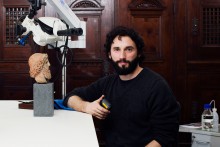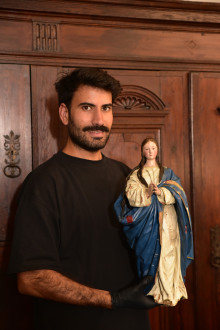What motivated you to devote yourself professionally to sculpture?
In a way, our paths were probably predetermined, since our hometowns of Ulm and Seville were centres of sculpture production in the past. The presence of medieval and baroque sculpture in the respective cityscapes, which cannot be overlooked—both cities have cathedrals of superlatives—has obviously exerted a strong influence on our careers.
What does a normal working day look like for you?
There is no such thing as a “normal working day”. Every day is different, as is every object we deal with. Between conservation work, research into new working techniques, exhibition preparations, and art-technological research, monotony doesn’t stand a chance. This is what makes our work at the Liebieghaus so exciting: the projects are extremely varied.
What is special about your work as conservators at the Liebieghaus?
What is special about our work at the Liebieghaus is that we are offered opportunities here that go beyond the usual conservation work. These include, for example, art-technological research into old painting techniques and materials. We try to trace these as precisely as possible through practical experiments and experimental reconstructions. In this way, we can use these techniques to rediscover lost knowledge and practically reconstruct how, for example, certain old painting materials were produced and processed. Similarly, in larger conservation projects, we try to tailor the working techniques to the object in question and, where necessary, refine the techniques to ensure the gentlest possible treatment of the works of art. The research and working processes involved are usually very complex and lengthy, but at the same time incredibly fascinating.
Harald Theiss’s studies in conservation, specialising in sculpture, initially took him from his hometown of Ulm to Dresden and Vienna. After completing his diploma thesis at the Staatliche Museen zu Berlin in 2000, he worked in various positions as a freelance conservator, among others for the Stiftung Preußischer Kulturbesitz in Berlin, the Bavarian and Brandenburg State Offices for the Preservation of Monuments, and the Staatliche Kunstsammlungen Dresden, Grünes Gewölbe. Harald Theiss also worked as a project employee at the Lower Saxony State Museum Hanover and as head of the sculpture restoration department at the Germanisches Nationalmuseum in Nuremberg. Since the fall of 2007, he has been Head of the Department of Art Technology and Conservation – Sculpture up to 1800 at the Liebieghaus Skulpturensammlung and is thus responsible for the conservation of the museum’s entire collection.
Miguel González de Quevedo Ibáñez completed his studies in conservation at the University of Seville in 2009. He then went on to study ceramic conservation at the Escuela de Formación de Artesanos de Gelves. From 2010, he worked on a conservation project at the Casa Ducal de Medinaceli Foundation in Seville; and in 2012, he participated in a conservation project of Baroque sculptures at the Laboratório de Figueiredo in Lisbon. From 2014, he was employed at the Instituto Andaluz del Patrimonio Histórico in Seville. Since 2016, he has been a staff member at the Liebieghaus Skulpturensammlung.









